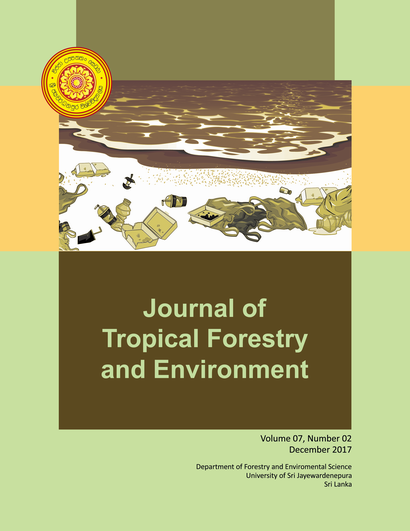Impact of Land Use Changes on Soil Properties and Organic Carbon Distribution Using Tracer Techniques in Selangor State of Malaysia
DOI:
https://doi.org/10.31357/jtfe.v7i2.3309Abstract
Root and litter biomass on carbon dynamics and its effect on other soil properties information are needed to explore in Malaysia due to rapid change of land use. Objective of this study was to determine the effect of root and litter biomass of forest and oil palm under different soil depths on soil organic carbon and its stock, soil available water, bulk density, pH, electrical conductivity. In this regard, two land use systems (forest and oil palm) were selected for the study. In each land use we collected litter biomass, root and soil samples from four different locations. For the characterization of soil and root three core samples were taken (0–5, 5-15, 15-30, 30-60 and 60-90 cm)from each location, and then combined and air-dried. Soil samples were air-dried for 2 weeks at room temperature, grounded and sieved (<2 mm). Soil available water content, soil organic carbon, pH and EC were determined by standard methods. Results revealed that maximum organic matter (6.75%) was found in forest soil at 0-5 cm depth of soil. SOC content was decreased with the increase of soil depth in forest. On average soil organic carbon stock was significantly higher under oil palm (3.09 t ha-1) than forest (2.28 t ha-1) up to 90 cm depth of soil. Available water content was higher in surface soil (0-15 cm) than subsurface soil due to mechanization of oil palm plantation area. Soil reaction (pH) was higher in forest soil than oil palm plantation soil. Litter biomass or droppings performed δ13C dilution in surface soil but root system enriched δ13C in subsurface soil. 13C isotope tracer technique confirmed that root and litter biomass of forest and oil palm plantation can greatly influence on vertical distribution of organic carbon when soils show gradual increase of δ13C values with depth.
Keywords: Land use, forest and oil palm, soil depth, carbon and tracer techniques
Downloads
Published
How to Cite
Issue
Section
License
The publisher retain the copyrights of contents published, and all open access articles are distributed under the terms of the Creative Commons Attribution-Noncommercial-No Derivative Works 3.0 Unported License[U1], which permits unrestricted use, distribution and reproduction in any medium, provided that the original work is properly cited.
You can download the Legal Code for this License at: http://creativecommons.org/licenses/by-nc-nd/3.0/legalcode


